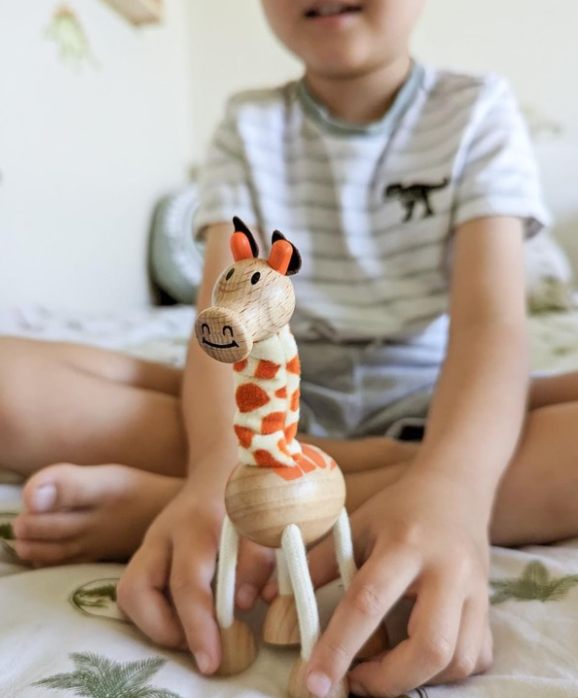Can too many toys harm a child’s development?

In a world dominated by consumerism, it's not uncommon for children’s rooms to be filled to the brim with toys. From the latest electronic gadgets to piles of soft toys and colourful building sets, it seems like the more toys, the better. But what if this isn't the case? What if having too many toys could actually be detrimental to a child's development? This blog explores how an overabundance of toys can impact a child's cognitive, emotional, and social development, and why a more minimalist approach may be beneficial.
The Hidden Consequences of Too Many Toys
While toys are often viewed as essential tools for child development, there’s a growing body of research suggesting that having too many can actually hinder a child's growth. Let’s delve into some of the potential downsides of toy overload:
1. Overstimulation and Stress
Children are naturally curious and easily excited. However, when they are surrounded by too many toys, their senses can become overwhelmed. This overstimulation can lead to feelings of stress and anxiety, making it difficult for children to relax and enjoy their playtime. According to Claire Lerner, a child development researcher, an excess of toys can prevent children from focusing on any one thing long enough to learn from it, causing them to feel overwhelmed and potentially even shutting down emotionally.
2. Shortened Attention Span
With so many toys to choose from, children often flit from one to the next without fully engaging with any single one. This can lead to a shortened attention span, as they become accustomed to the constant novelty and quick rewards of switching between toys. In contrast, having fewer toys encourages children to spend more time exploring each one, fostering longer periods of focus and deeper cognitive engagement.
3. Reduced Creativity and Imagination
Toys that are designed with specific functions or outcomes in mind can limit a child’s creative potential. For example, electronic toys that talk, light up, or move on their own do much of the thinking and imagining for the child. When children are given fewer, simpler toys, such as building blocks or figurines, they are encouraged to use their imaginations to create their own stories and worlds. This type of open-ended play is crucial for developing creativity and problem-solving skills.
4. Increased Conflict and Possessiveness
Paradoxically, more toys can lead to more conflicts among children. When there are numerous toys available, children may become possessive, arguing over who gets to play with what. This can hinder the development of cooperative play and sharing. Fewer toys mean children must share and negotiate, skills that are essential for building strong social relationships.
5. Lack of Appreciation and Responsibility
Children who are overwhelmed with an excess of toys may struggle to appreciate and take care of them. When toys are easily replaced or when there are always more options available, children may not learn to value their belongings. This can lead to a lack of responsibility and a tendency to discard toys carelessly, which can also extend to other aspects of their lives.

The Psychological Impact of Too Many Toys
Research has shown that an overabundance of toys can affect a child’s emotional and psychological well-being. A study conducted by researchers at the University of Toledo found that toddlers who were exposed to fewer toys played longer and more creatively with each toy compared to those who had access to many. This suggests that too many toys can actually limit the quality of playtime, leading to superficial and less meaningful play.
1. Decision Fatigue
Having too many options can be overwhelming, even for adults. For children, an overabundance of choices can lead to decision fatigue, where they struggle to choose what to play with and may end up feeling frustrated or disengaged. This can stifle their ability to enjoy their playtime and develop a sense of mastery and satisfaction from their activities.
2. Increased Anxiety and Impatience
Constantly being exposed to new and exciting toys can make children more impatient and anxious for the next new thing. This can lead to a lack of contentment and an inability to find joy in what they already have. It can also contribute to a mindset that is more focused on acquiring possessions rather than valuing experiences or relationships.
The Benefits of a Minimalist Toy Approach
Adopting a minimalist approach to toys doesn’t mean depriving children of fun or learning opportunities. On the contrary, it allows them to engage more deeply with the toys they do have, fostering a richer and more meaningful play experience. Here’s how fewer toys can benefit a child’s development:
1. Enhanced Focus and Problem-Solving Skills
With fewer toys to choose from, children are encouraged to use their creativity and problem-solving skills to make the most of what they have. They learn to engage deeply with their toys, exploring different possibilities and solutions. This not only improves their cognitive abilities but also teaches perseverance and patience.
2. Improved Social Skills and Emotional Intelligence
When children have fewer toys, they are more likely to engage in cooperative play with their peers. They learn to share, take turns, and communicate effectively. This helps build emotional intelligence and empathy, as children must navigate their social environment more thoughtfully.
3. Greater Appreciation for the Environment
Fewer toys often mean choosing toys that are of higher quality and more sustainable. Eco-friendly toys made from natural materials like wood or organic cotton are not only better for the environment but also teach children to value sustainability and care for their planet from a young age.
4. Encouragement of Outdoor Play and Exploration
With fewer toys indoors, children are more likely to seek entertainment outside. Outdoor play encourages physical activity, exploration, and a connection with nature. This type of play is essential for physical health, mental well-being, and overall happiness.
How to Implement a Minimalist Toy Approach
If you’re considering reducing the number of toys in your home, here are some practical steps to help you get started:
1. Declutter Regularly: Go through your child’s toys regularly and donate or store away those that are no longer being used. Keep only the toys that your child truly enjoys and plays with.
2. Choose Open-Ended Toys: Invest in toys that can be used in multiple ways, such as building blocks, dolls, or art supplies. These types of toys encourage creativity and can be used for a variety of play scenarios.
3. Rotate Toys: Store some toys out of sight and rotate them periodically. This keeps playtime fresh and engaging without overwhelming your child with too many options at once.
4. Prioritise Experiences Over Material Goods: Consider giving the gift of experiences, such as trips to the zoo, museums, or outdoor adventures, instead of more toys. These experiences are often more memorable and enriching.
5. Educate Relatives and Friends: Let well-meaning relatives and friends know about your minimalist approach to toys. Provide them with alternative gift ideas, such as books or art supplies, to avoid an influx of unnecessary toys.

Anamalz: A Perfect Example of Quality Over Quantity
For parents seeking sustainable, open-ended toys, Anamalz offers the perfect solution. These beautifully crafted toys are made from sustainable wood and designed to inspire imaginative play. With their simple, tactile design, Anamalz toys encourage children to create their own stories and explore the world of animals, without the need for an overabundance of toys.
Why Choose Anamalz?
- Eco-Friendly Materials: Made from responsibly sourced wood and non-toxic paints, Anamalz toys are safe for children and the planet.
- Durable and Long-Lasting: Built to withstand years of play, Anamalz toys are an investment in quality and sustainability.
- Encourages Imaginative Play: The open-ended nature of Anamalz toys allows children to create endless play scenarios, fostering creativity and problem-solving skills.
Conclusion: Less Is More
In a culture that often equates more with better, it's essential to remember that when it comes to toys, less can truly be more. An overabundance of toys can overwhelm children, stifle their creativity, and hinder their development.
If you're looking to adopt a more sustainable and minimalist approach to toys, here are some other eco-friendly brands we love that prioritise quality, safety, and environmental responsibility:
- PlanToys
- Green Toys
- HABA
- Grimm’s Spiel und Holz Design
- Olli Ella
- Tender Leaf Toys
- Wishbone Design Studio
- EverEarth
By embracing a minimalist approach and choosing fewer, high-quality toys like Anamalz, parents can provide their children with a richer, more meaningful play experience.



Share and get 15% off!
Simply share this product on one of the following social networks and you will unlock 15% off!